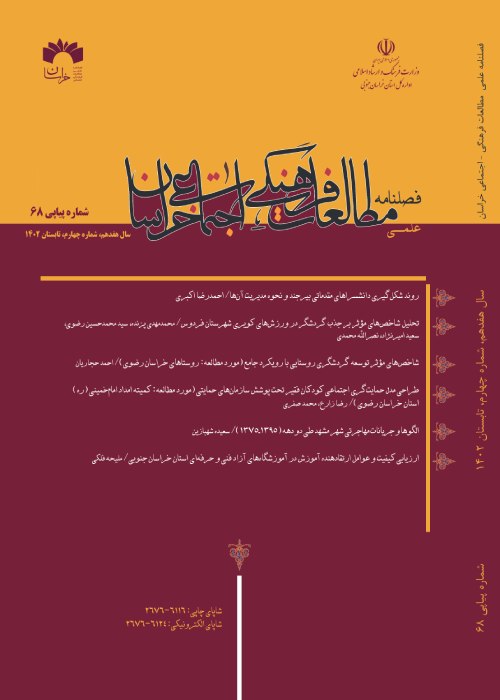Cultural anthropology of pastoral life system in Kermanjiˈs Seh – kheshti of North Khorasan
Sih-Khashti is a branch of poems surviving from the tradition of Khosravani and Kheniagari before Islam, which apparently made its way to Khorasan in the northeast of Iran after the migration of the people of Kermanj in the early Safavid period (Tavhodi, 1359: 5). These type of poems are three-stanza compositions in the syllabic weights which are sung together with instruments and vocals, and acoustic and vocal music forms a part of their weighted identity (Alipour,1395: 115). These hymns' major themes are life, love, hope, the recounting of tragedies, the melancholy of earlier eras, tears, hope, desire, wishes, the dreams of the pure and Illyrian people, and patriotism (Hosseinpour, 1389: 6–8). Reflecting on the images in the three kashties reflects the mountainous origin, and green plains, the nomadic life of the tribes, and nomads. Homelessness, war, killing and captivity are other central themes of the three clays that depict the lived experiences of the Kermanj people against the invasions of Uzbeks, Russians, and Turkmens (Alipour, 1395: 127). Therefore, three clays are the result of pastoral life organization, which, like other works of art, is a manifestation of the culture, rituals and religious beliefs of its authors. The customs, such as choosing a wife, choosing a son-in-law, holding celebrations and holidays, religious beliefs and believing in prayers and curses, superstitions and common games, how to divide work, issues related to moving and living, etc., are among the things which are mentioned in the linguistic levels of these poems are reflected; Therefore, upcoming research tries to answer these questions by examining the Kermanji three clay tiles based on the theory of cultural anthropology: 1. What are the phenomena of culture in the Kermanji's sih-khishti? 2. What is the belief system of the culture in Kermanji's sih-khishti?
One of the new disciplines around culture is cultural anthropology. In fact, anthropology is the science of studying man, and his culture in order to gain real knowledge about human differences. Cultural anthropology studies man as a living cultural animal (Haviland, 2012: 32). The goal of this field, known as cultural anthropology, is to understand the cultural patterns that guide human behavior both historically and now (Bates and Plague, 2007: 37); Since culture refers to the beliefs and practices of human communities, this discipline is heavily reliant on it. Culture is investigated from a variety of viewpoints, including totalism, comparativism, and relativism (Pipelz, 2010: 21, 29). The authors have analyzed the pastoral life systems of Kermanj people in Se-Khashti with a descriptive-analytical method, citing documents and library sources, and based on the cultural anthropological approach. This study is based on the book "Sehakhshti" of Kermanji by Hadi Bidaki (1395) from among 1386 Sehkhsti, 1000 Sehkhsti were selected to analyze different patterns of pastoral life, and their meaningful relationship with the cultural structure of nomadic life. be examined.
By reference to 1000 sih-khishti, with the approach of functionalism, and structuralism of cultural anthropology, firstly, the manifestations of the phenomenal order and beliefs of the culture of Kermanj tribes in the form of pastoral patterns, such as the migration pattern, the family pattern, the marriage pattern, the mourning pattern, the division of labor pattern, the pattern of rituals and religion and the game pattern was extracted. After that, each phenomenon's function and involvement in the shepherds' social structure were examined.
The present study shows that the family system, marriage, clothes, games, individual, and family duties, religious structure and the process of change from nomadism to monogamy are reflected in these poems. The study of cultural anthropology of family organization among the nomads indicates that the family is formed based on their livelihood and economic needs. Moreover, people's need for each other to produce food has led to creating extended families among nomads; But gradually, by becoming a replacement and turning to other occupations, such as agriculture, the family system has progressed towards nuclear families. Sih-khishti genealogy of marriage patterns reveals that economic issues have been the root cause of the young marriage age among nomadic females. The value of preserving blood links and riches among clan members is shown through marriages to other clan members, family relationships, and the abhorrence of such unions. The nomadic families used sheep, camels, chickens and goats for their daughters' shirbaha, or the equivalent of money, and taking shirbaha was to compensate the loss of the girl's family for the loss of their production power. Cutting the hair and grabbing the head and face, as well as using a black coffin, are among the cultural symbols of Kermanj people's mourning, which are reflected in the sih-khishti. Wool spinning and horse racing are common games among Kermanj nomads; which is affected by gender and environment. Furthermore, being a Muslim and a Shiite, adhering to religious duties, such as fasting and praying and mourning in the month of Muharram, fatalism, especially in the matter of marriage, devotion to imams and especially Imam Reza, belief in magic and sorcery, prayers, and curses. One of the three-stones' mirrored religious patterns is what led to the presence of academics and clerics there. Besides, respect for some animals, such as camels and white sheep, rams, as well as some plants such as tulips and roses can indicate the totemic patterns of Kermanj clans. The architecture reflected in the sih-khishties shows the process of changing the nomadic pattern (using black tents) to monogamous (using porches, attics, etc.).
- حق عضویت دریافتی صرف حمایت از نشریات عضو و نگهداری، تکمیل و توسعه مگیران میشود.
- پرداخت حق اشتراک و دانلود مقالات اجازه بازنشر آن در سایر رسانههای چاپی و دیجیتال را به کاربر نمیدهد.


